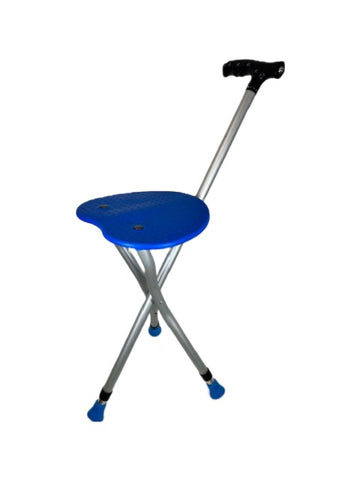Disclaimer: our company makes and sells the Giraffe Rolling Cane
A quick internet search reveals that in 2015, 16.4% of older Americans used a cane for walking.
There are many types of canes for walking and deciding which is the best for you may feel a little challenging. Six of the most common types of walking canes are single-point canes, pivoting feet canes, multiple-point canes, rolling canes, folding canes, and seat canes. All of these are appropriate walking canes for men or women. There is no "one" best cane for walking because it depends on the user's needs.
Although some people have a negative attitude about using a walking aid, I believe a cane promotes independence. A person may be more independent and safer if they use an appropriate walking device than if they don’t use one.
A cane may positively impact small balance issues by adding an extra point of contact with the ground. This increases the base of support and improves stability. Canes can also provide sensory feedback to the brain for safer walking. In addition, they can take pressure away from a painful leg which may help with balance. Using a cane on the opposite side of the weaker or painful leg will shift weight onto the cane and away from the weaker or painful side. A cane can provide up to 25% support for the user. If a person needs more support, they should use a walker. Most canes have a user weight limit between 250 and 350 pounds.
It's important to use a cane that feels comfortable and is the correct height. Most canes are adjustable. When adjusting a cane for your height, aim for a 15 - 30 degree bend in your elbow when your hand is on the handgrip. If you have a painful leg that you are trying to shift the weight away from, a lesser bend in the elbow (15 degrees) is better. This allows for more weight transferred through the cane.
Types of Canes
Single-Point Canes

Single-point canes have a single shaft and a single tip with a rubber gripper on the end. The tip helps provide traction with the ground and prevents the cane from slipping. Ensuring that the tip is not too worn is important to provide safe use. Single-point canes are lightweight, have a simple design, and are inexpensive. They are good for people who need light to moderate support. These canes can be difficult for some people to coordinate the proper sequencing of moving the cane with their stepping. They also are not freestanding and often fall on the floor.
Pivoting Feet Canes


Pivoting feet canes have a single shaft and a pivoting tip or base on the ground end. They are more freestanding than a single-point cane but can still fall relatively easily. They provide good traction with the ground and are good on uneven surfaces. Like single-point canes, some people may find it challenging to coordinate the proper sequencing of advancing the cane with their walking pattern.
Multiple-Point Canes

Multiple-point canes have a single shaft with either three (tripod) or four (quad cane) separate prongs at the base. These canes are freestanding and provide more stability than single-point canes. They can become off-balanced on uneven surfaces and feel awkward to use for some people. These canes are best for someone who walks slowly. People who have one-sided weakness from a stroke or hip or knee pain may benefit from a quad cane.
Rolling Canes


Rolling canes have wheels that allow them to roll instead of picking them up with each step. It takes less energy to use a rolling cane compared to a quad cane. These canes are freestanding and some, such as the Giraffe Rolling Cane are a cane with 4 legs. The Giraffe Rolling Cane also has a convenient basket. Rolling canes are good for people with arthritis or arm weakness because they don’t have to grip them so tightly. They may also be beneficial for people who have one-sided weakness from a stroke or hip or knee pain.
Folding Canes


Folding canes are single shaft canes that collapse or fold into a compact size. They may have a single-point tip or a pivoting base. These canes are good for active people who are on the go. The folding feature allows these canes to be stored away in a large purse or tote bag. After unfolding the cane for use, it is important to check the cane to ensure it is secure.
Seat Canes


Seat canes provide a dual purpose; they provide a cane for support and a seat for resting. The seat is usually folded up or down out of the way while walking with the cane. The user unfolds the seat when it's needed. Seat canes are good for people who walk long distances and/or need frequent seated rest breaks. These canes are sometimes heavier than other canes because they are made of sturdier materials. The seat is usually not very large and often has no back support.
In closing, there are many considerations when deciding on a cane to use for walking. For more assistance, consult with your licensed medical professional to determine the best cane for you. Using an assistive device for walking may help you to be safer and more independent.
Click here for the Ultimate Guide to the Giraffe Rolling Cane
Check out our website for more information www.GiraffeRollingCane.com
Videos on YouTube:
Giraffe Rolling Cane Instructional Video https://youtu.be/CUkBfFBSrM4
Giraffe Rolling Cane Features & Benefits https://youtu.be/h_AaSdK0FdA


